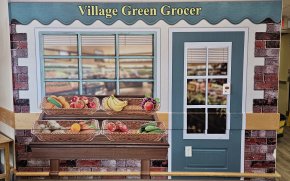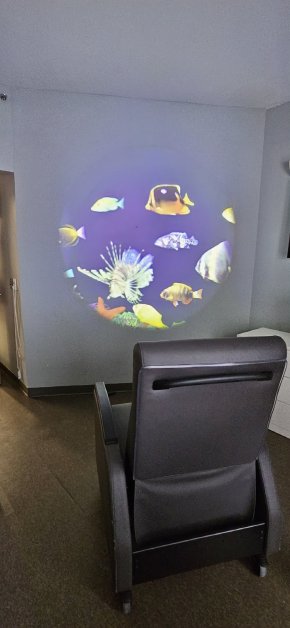
Engaging the Senses: Transformative tools for dementia care in the BSTU at Extendicare McGarrell Place
TweetIn the Behavioural Support Transitional Unit (BSTU) at Extendicare McGarrell Place in London, Ontario, 29 residents receive holistic care tailored to the complex behavioural needs of people living with Alzheimer’s disease and other forms of dementia. Transitioning to long-term care can be a challenge for new residents with changes in routine, new faces, and unfamiliar environments, which can be overstimulating.
The BSTU uses sensory-focused tools and technologies to respond to triggers and provide residents with a calming environment that promotes a sense of familiarity and comfort.
Take a walk through the BSTU at McGarrell Place to discover the tools and techniques at work:
Designed for function
Dining spaces are designed to foster community while ensuring personal space, using cloverleaf-shaped tables that accommodate mobility device users and maintain each resident’s personal space during meals. These uniquely-designed tables also allow care teams greater space and access to assist residents, ensuring mealtime is a positive, nourishing experience.
The walls of the home feature puzzles, fidget boards, and interactive murals along the hallways, offering residents activities that help maintain dexterity and cognition while providing a calming distraction from other stimuli.
For many people living with dementia, senses can be heightened and feelings of being overwhelmed are common. To help mitigate these symptoms, different senses including sight, smell, sound and touch are engaged throughout the BSTU with its thoughtful design and decor, as well as programs for residents. Pet therapy visits offer tactile stimulation, music programming helps spark familiar memories, and using aromatherapy diffusers, soothing smells, selected specifically for each resident, create calming spaces and elicit relaxation.
Never far from home
During the intake process at McGarrell Place’s BSTU, the team members embrace a personalized approach to dementia care by leveraging technology to create moments of comfort and connection. Families are encouraged to record short, heartfelt videos on iPads, offering reassuring messages that team members can play when residents experience confusion or loneliness. These videos help bridge the gap caused by dementia-related memory loss, bringing familiar voices and faces into challenging moments.
The iPads are also invaluable for soothing overstimulation or distress by playing a resident's favorite music, showing videos, or providing calming distractions tailored to their unique interests.
“The iPads are amazing,” says Sarah, Resident Program Manager at McGarrell Place’s BSTU. “It’s that quick access, whether that is accessing music, movies or activities to engage them in, you can pull up anything you know might help.”
By weaving technology with compassion, the BSTU creates a nurturing environment that helps residents feel at home and supported.
Integrating technology into person-centered care
Digital tools like iPads and virtual reality are integral to daily care at McGarrell Place. The connection between music and memory is well known here. The BSTU team works with residents and family members early on to source favourite songs and artists to build playlists that team members can quickly access on an iPad.
"When residents exhibit stress, confusion, or agitation, the soothing sounds of music are at their fingertips," notes Sarah.
In addition to music and messages from families, virtual reality programs engage residents in stimulating activities that integrate technology into care, allowing them to explore virtual environments or participate in interactive tasks that enhance cognition and movement.
“We can use iPads and VR technology not only to access information quickly but utilize tools to set up enjoyable experiences for our residents,” adds Sarah.
Care for the brain, starting with the body
Physical comfort is prioritized with tools like a specialized wellness chair, which offers a calming multi-sensory experience through music, tactile stimulation, and movement. Available to all BSTU residents, massage pads, weighted blankets, and deep compression vests can help regulate sensory input and reduce anxiety.
“The deep compression vest provides a similar feeling to a hug, but one they can wear,” explains Sarah.
These tools provide residents with a sense of security and comfort, helping them better cope with their environment.
Residents at McGarrell Place undergo a comprehensive intake and assessment process where individual care needs and plans are discussed. In the BSTU, residents receive 24/7 personal support services and the services of an interdisciplinary team of nurses, physicians, dieticians and physiotherapists, as needed. All BSTU residents have access to a geriatric psychiatrist who specializes in changes and challenges faced by older adults.
At McGarrell Place, the comprehensive approach to dementia care in the BSTU integrates sensory, technological, and physical strategies to create a nurturing environment. By addressing the complex behavioural needs of each resident, the home provides a compassionate, individualized experience that supports well-being and enhances quality of life in every aspect of their daily routine. The BSTU ensures that residents are treated with dignity and respect, and receive the care they need, wherever they call home.

